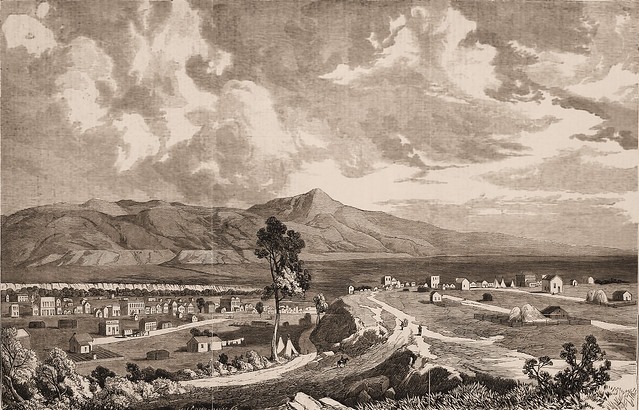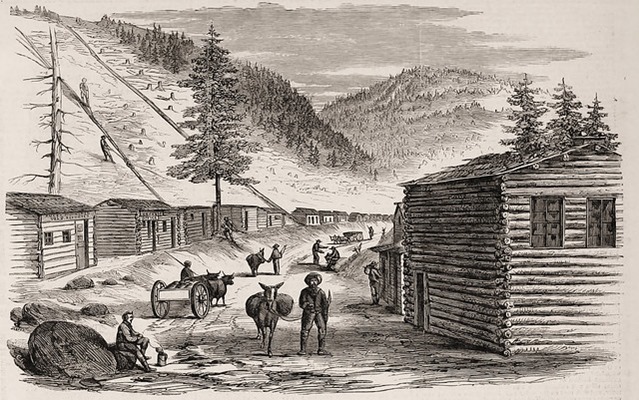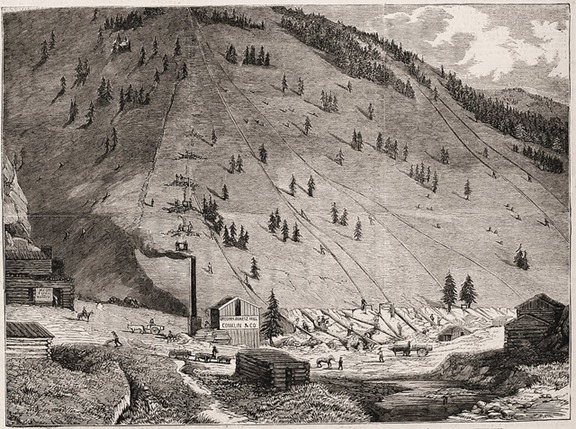Pike’s Peak and Long’s Peak.

The Kansas Gold Region—View of Auraria and Denver City,
Cherry Creek—from a sketch made by Col D. H. Huyett,
Expressly for Frank Leslie’s Illustrated Newspaper
That part of the Rocky Mountains which is called Pike’s Peak was discovered, or rather named by Lieutenant Z. M. Pike, who made an exploring expedition under the authority of the United States Government in 1807. According to his measurement, its altitude is ten thousand five hundred and eighty-ono feet above the level of the prairie, or eighteen thousand feet above the level of the sea. It was then renowned among the savage tribes for its wonderful altitude, and regarded with almost a species of veneration by their untutored minds.

Street in Gregory’s Gulch, Pike’s Peak. –From a sketch made on the spot,
expressly for Frank Leslie’s Illustrated Newspaper, By Col. D. H. Huyett
The gold regions, according to some accounts, extend about two hundred to three hundred miles north and south, and from fifty to one hundred east and west, and are situated to the south-west of Nebraska, the west of Kansas and the north of New Mexico. Lieutenant Pike states that in his wanderings, from the 14th November to 27th January, the Peak towered into the skies, the great object of vision, and was never out of sight except when they were in some deep valley. The summit of this remarkable mountain is
bare of vegetation, and is constantly covered with snow. The snow line is above one thousand eight hundred feet above the three small mountain lakes described by Fremont. Standing upon this peak, you behold innumerable streams and lakes, and a vast stretch of prairie to the south-east, east and north-east, dotted here and there with immense herds of buffalo; while around, on either hand, the ridge is split into chasms and fissures, between which rise their lofty walls, terminating with slender minarets and columns, which impress one with the conviction that this chain of mountains was thrown up by some terrible convulsion of Nature. The summit rock is gneiss, succeeded by sienite. and feldspar continues to the snow line, where is found the feldspathic granite.
Mrs. Holmes, of Lawrence, Kansas, who was the first woman to ascend Pike’s Peak, gives a very glowing description of the magnificent view from its summit. She says, “Think of the huge rocks projecting out in all imaginable shapes, with the beautiful eve-greens, the pines. the firs, the spruces interspersed among them, and then the clear, cold mountain stream, which appears as though it started right out from under some great rock, and on it goes, rushing, rumbling and hissing down over the rough mountain side, now sparkling in the sunbeams, and hiding behind some huge rock. Extending, as far as the eye can reach, lie the great level plains, stretched out in all their verdure, while the winding of the Arkansas River is visible for many miles.”
The reader will perceive that the mountain sides are covered with creeks or rills, which stream down, and at certain places rest and form small lakes. The washings of the eastern slopes are particularly rich. Along the banks of Cherry Creek, the Fontaine que Bouille, the South Platte, and smaller affluents in the vicinity of Pike’s Peak, surface explorations have shown an abundance of precious metals. Farber along there are equally promising appearances in the Three Parks, and southward, among the huge formations that skirt the Rio Bravo del Norte.
Pine trees of immense size and is large tracts grow along the base of the mountains, and the spruce is scattered along the mountain side. Some of the streams are skirted by timber, and upon the plains are large groves of noble great pines that shoot up a hundred feet high, clear of limbs and straight as an arrow. The sides of the Mountains are indurated with gullets, as they are termed, caused by the melting of the snows, and these are made serviceable by being converted, as it, were, into patent washers.
The towns of Auraria and Denver, of which we give faithful and graphic pictures, are situated near the month of Cherry Creek, where the roads from Bent’s Fort and Taos meet. They are remarkable proofs of the agency of gold in the creation of towns, and are doubtless destined to become great cities, even when the present gold excitement bas passed away. The climate of these regions is so delightful and invigorating, that no more favorable spots can be found for health and longevity. Auraria and Denver cities are situated at the base of Long’s Peak, a mountain summit of the Rocky Mountains. Pike’s Peak is situated 38.25 north latitude, and 105 west longitude. Long’s Peak is in 40.10 north latitude, and 106 west longitude.

Sketch of Gregory’s Quartz Mill, Pike’s Peak, Made on this Spot by Col. D. H. Huyett,
Expressly for Frank Leslie’s Illustrated Newspaper
Mr. Greeley in his amusing work thus describes Auraria and Denver cities. as they appeared to him in June, 1859: ” The rival cities of Denver and Auraria front on each other from either bank of Cherry Creek, just before it is lost in the South Platte. The Platte has its sources in and around the South Park of the Rocky Mountains, a hundred miles southwest of this point; but Cherry Creek is headed oil from them by that river, and winding in its northward course of forty or fifty miles over the plains, with its sources barely touching the mountains, is a capricious stream, running quite smartly when we carne here, but whose broad and thirsty sands have since drank it ail up at this point, leaving the log foot-bridges which connect the two cities as useless as an ice-house in November.
“Of these rival cities. Aurelia is by far the more venerable—some of its structures being, I think, fully a year old, if not more. Denver, on the other hand, can boast of no antiquity beyond September or October last. In the architecture of the two cities there is, not withstanding, a striking similarity—cotton-wood logs, cut from the adjacent bottom of the Platte, roughly hewed on the upper and under sides and chinked with billets of spit cotton-wood on the inner, and with mud on the outer side, forming the walls of nearly or quite every edifice which adorns either city. Across the centre of the interior, from shorter wall to wail, stretches a sturdy ridge pole, usually in a state of nature, from which “shooks” or split saplings of cotton-wood, their split sides down, incline gently to the transverse or longer sides; on these (in the more finished strucures) a coating of earth is laid; and, with a chimney of mud-daubed sticks in one corner, a door nearly opposite and a hole beside it representing or prefiguring a window, the edifice is complete. Of course, many have no earth on their covering of shooks, and so are liable to gentle inundation in the rainy season; but, though we have had thunder and lightning almost daily, with a brisk gale in most instances, there has been no rain worth naming such here for weeks, and the unchinked, barely shook covered houses, through whose sides and roofs you may see the stars as you lie awake nights, are decidedly the cooler and the airier. There is a new hotel nearly finished in Auraria, which has a second story (but no first story) floor; beside this, mine eyes have never yet been blessed with the sight of any floor whatever is either Denver or Auraria. The last time I slept or ate with a floor under me (our wagon box and mother earth excepted) was at Junction City, nearly tour weeks ago. The Denver House, which is the Astor House of the gold region, has walls of logs, a floor of earth with windows and roof of rather flimsy cotton-sleeting; while every guest is allowed as good a bed as his blankets will make.”